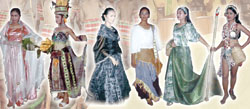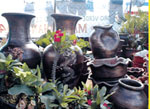Dinagyang Festival is one of the Famous and World renowned Festival in the Philippines. Iloilo people are proud to celebrate the festivities every fourth Sunday of January. The Dinagyang Festival is a very colorful festival that the people are shouting the thundering words of "Hala Bira" and makes the celebration so lively. The highlights of the fiesta is the Street dancing of different tribes to honor kalibo's patron Saints Senyor Santo Niño saying "Viva Señor Santo Niño".
This is the decorated banca
Dinagyang had its humble beginnings in the devotion to the Señor Santo Niño that began to take root in the hearts of Ilonggos some 40 years ago. Rev. Fr. Ambrosio Galindez started to introduce the devotion to Santo Niño in November 1967, with the usual novenas and masses in honor of the latter.
The first parish feast of the Señor Santo Niño was celebrated in 1969, a year after the arrival. The main feature of the feast was the first fluvial procession where the image was borne on a decorated banca, starting from the mouth of Iloilo river at Fort San Pedro, down to Iloilo Provincial Capitol and back to San Jose church.
Dinagyang traces its roots to the staging of an ati-atihan, a dance festival where performers paint their bodies black to look like the dark Aetas, about three decades back. Through the years, however, the Dinagyang festival has not only meant fun and laughter for the Ilonggos. It has also become a period of thanksgiving and offering for all the blessings received.
Daguy is the official Mascot of Dinagyang Festival
A day before the Dinagyang Festival start there is a Food Festival at Delgado Street and Valeria Street.
Ati-Atihan in Kalibo
The name Ati-Atihan means "make-believe Atis. " It has been known as the wildest among Philippine fiestas. The Ati-Atihan is a festival in honour of the Santo Niño. During the last three days of this week-long festival (fiesta), a parade is characteristic. A colourful happening with celebrants who paint their faces in many different ways and who are dressed in the most outstanding costumes.
The Ati-Atihan festival is named after the Ati, the indigenious natives of the island before the arrival of the Malay in the 10th century and the Spanish in the 16th century.
The festival is held on the third week of January every year on the second Sunday after Epiphany in Kalibo in the Aklan province on the island of Panay. The festival is to rejoice the arrival or gift of the Santo Niño by Magellan to the native Queen of Cebu in 1521 and is manifested by hyperactive merriment on the streets . The dancing on the rhythms of the drums makes this festival very similar to the Mardi Gras celebration in Rio in Brazil.
The Ati-Atihan festival is named after the Ati, the indigenious natives of the island before the arrival of the Malay in the 10th century and the Spanish in the 16th century.
The festival is held on the third week of January every year on the second Sunday after Epiphany in Kalibo in the Aklan province on the island of Panay. The festival is to rejoice the arrival or gift of the Santo Niño by Magellan to the native Queen of Cebu in 1521 and is manifested by hyperactive merriment on the streets . The dancing on the rhythms of the drums makes this festival very similar to the Mardi Gras celebration in Rio in Brazil.
ATI-ATIHAN is one of the greatest, most colorful and fun festivals. It's nickname, "The Filipino Mardis Gras" and takes place the 3rd weekend in January every year in Kalibo, Aklan, Panay Island,
Philippines. Iloilo and many other smaller towns on Panay Island also party the festivals during the weekends from mid January to early February so if you miss the Kalibo festival you could still experience fun elsewhere. The informality of the festival is what makes it so terrific and allows everyone to participate, dance, beat on a drum or just take photos while in the middle of the tribal groups. The groups include all age groups - another wonderful aspect of the festival. Some of the most creative costumes distinct to the tribal themes are displayed by a few of the local gays. The festival includes every local group in Aklan with a unique tribal tradition, various civic or commercial organizations and individuals that create new costumes every year.
The key activity of the festival and one of the main reasons tourists gather to the island is the native dance competitions pitched to rhythmic and mesmerizing drumbeats that run nonstop for several days. Competitors rehearsed for weeks before the festival and dress in very colorful costumes, wearing masks and headdresses, and paint their bodies with black ash to turn up like the native Ati. Dancing troupes, some numbering 40 or 50 children or teenagers, dance for local prestige and cash prizes.Philippines. Iloilo and many other smaller towns on Panay Island also party the festivals during the weekends from mid January to early February so if you miss the Kalibo festival you could still experience fun elsewhere. The informality of the festival is what makes it so terrific and allows everyone to participate, dance, beat on a drum or just take photos while in the middle of the tribal groups. The groups include all age groups - another wonderful aspect of the festival. Some of the most creative costumes distinct to the tribal themes are displayed by a few of the local gays. The festival includes every local group in Aklan with a unique tribal tradition, various civic or commercial organizations and individuals that create new costumes every year.
Manggahan Festival in Guimaras
It has been 12 years since the island of Guimaras was proclaimed an independent province. Every year, Guimarasnons express their colorful way of life through a festival called Manggahan Festival sg Guimaras. The island is not only known locally and nationally for its fresh and bountiful harvest of mangoes, but also for the artistry of its people.
 |
The Lin-ay sg Guimaras is also one of the events that draw attention annually.
 |






No comments:
Post a Comment